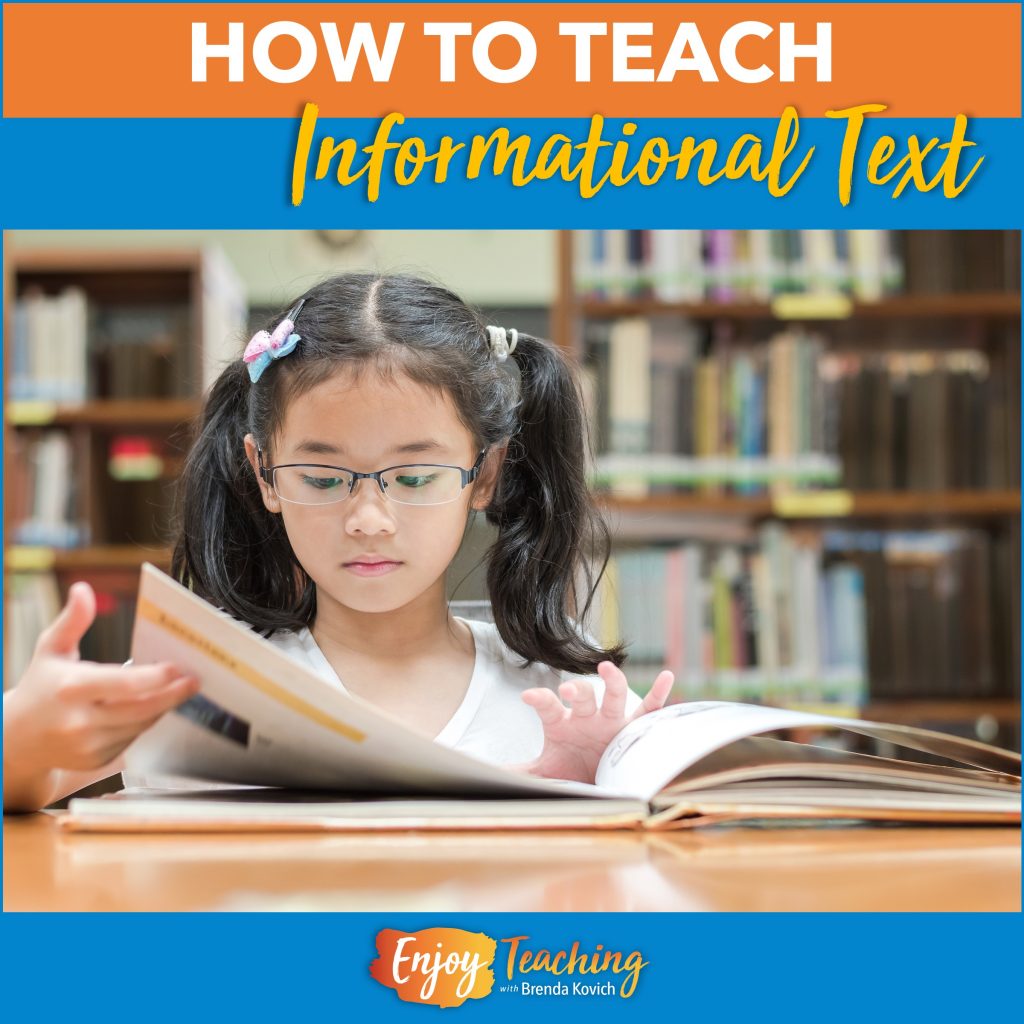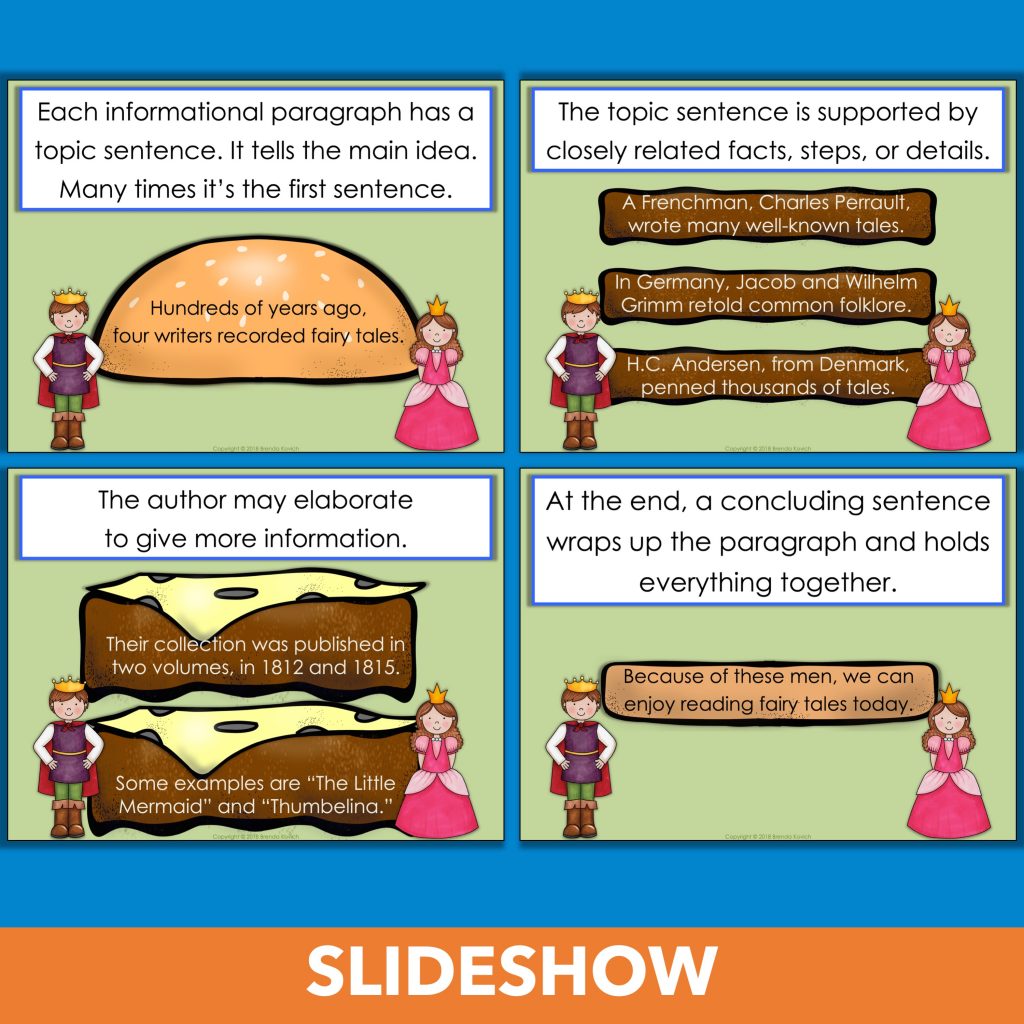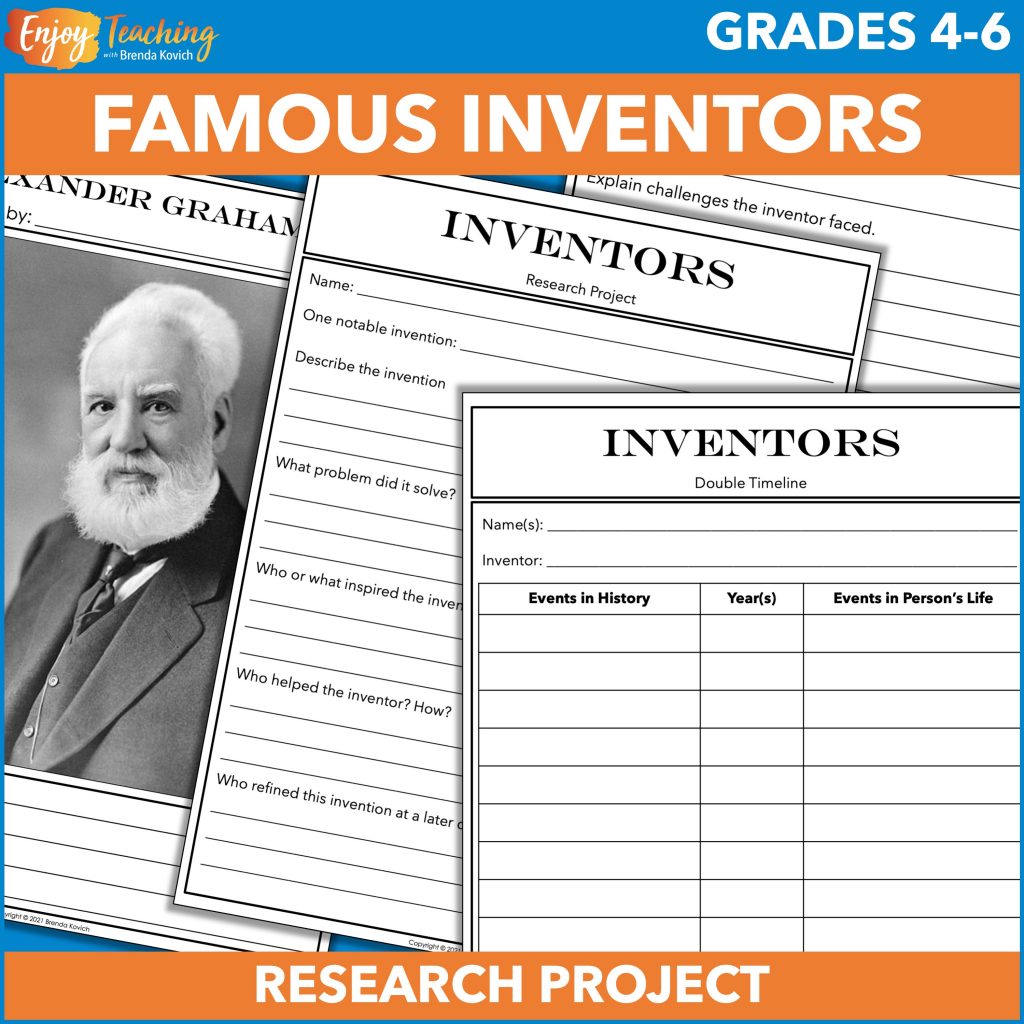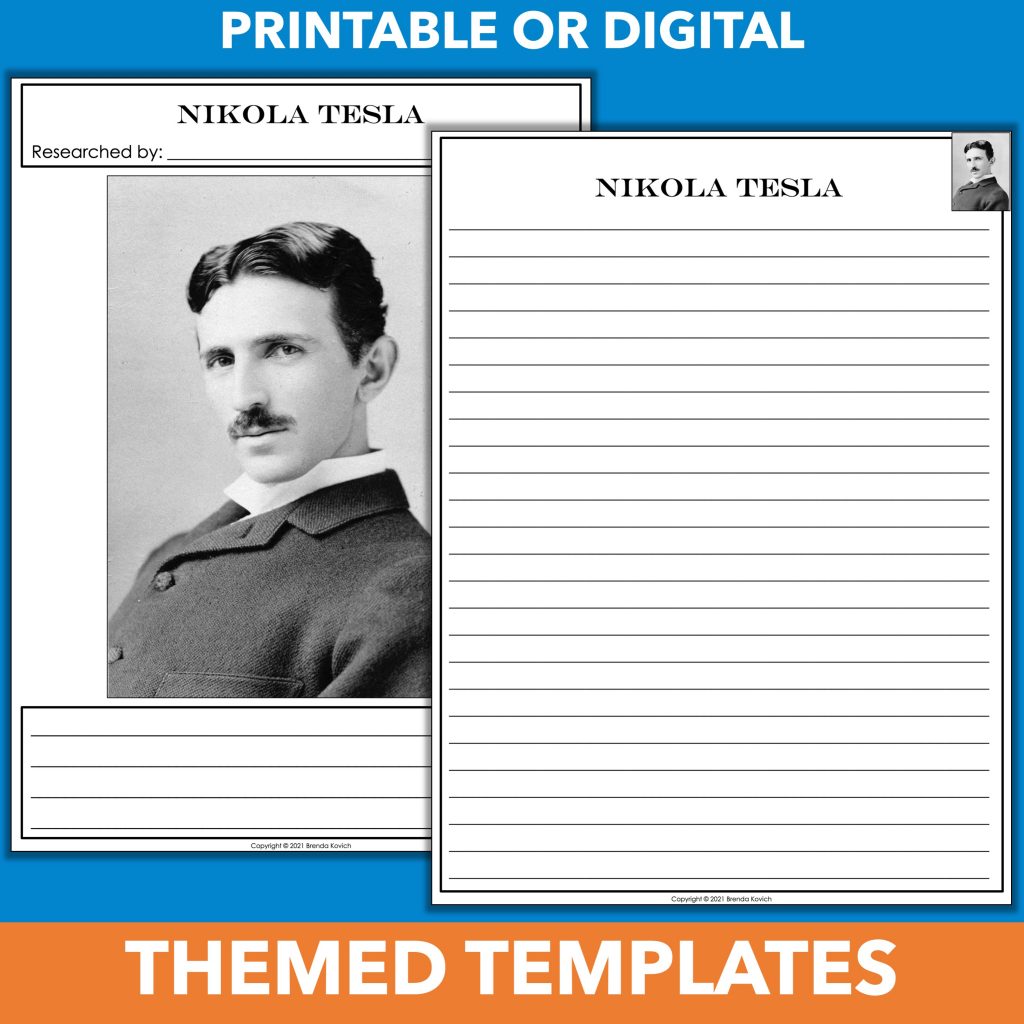Teaching informational text to third, fourth, or fifth graders? Surprisingly, you can use your science or social studies book for most skills. Read on for ideas to get started.
Estimated reading time: 22 minutes

Table of contents
Although standards for nonfiction vary from one locale to another, most are similar to the Common Core State Standards (CCSS), which are used in this article. Read on for ideas for teaching informational text in your ELA block, as well as other subject areas.
Use highlighted text to read more; click buttons to access instructional resources.
Teaching Informational Text for Key Ideas and Details
Answering Questions
Constructed response is also taught in the literature strand, and your class can apply the same strategies to nonfiction. First, students locate evidence from the text. Second, they write a topic sentence that answers the question. Third, they support the answer with evidence from the text. In addition, kids must refer to the text, or cite.
No extra materials are needed. You can ask your class to practice this skill with questions in your social studies or science book.
At each grade level, begin teaching informational text questions orally. Once they’ve mastered it, move to supported responses. Finally, ask them to respond in written form. (As you learned in your education courses, a complete learning cycle – direct instruction, modeling, guided practice, and independent practice – promotes mastery.)
For this standard, paraphrasing is essential. Before kids learn to quote in fifth grade, responses must be written in their own words.
Third Grade
When teaching informational text to third graders, encourage them to “ask and answer questions to demonstrate understanding of a text.” Additionally, they must refer to the text in their answer.
Asking Questions
As you read aloud about science or social studies topics, ask questions like:
- who or what
- when
- where
- how
- why
Also delve into:
- why it matters (or why we learn about it)
- what caused it and what it caused
Make and display a classroom list of questions to ask oneself while reading informational text. Then, as time goes on, encourage kids to phrase and answer their own questions.
Referring to the Text
You can also teach kids to refer to the text orally. As they answer oral questions, train them to use phrases like:
- The author states,…
- In “[title of text],”…
Then, as they begin to answer in written form, ask them to continue this practice.
Fourth Grade
In fourth grade, students must “refer to details and examples in a text,” which requires citing. At this level, kids must also draw inferences.
Analyzing Questions Orally
First, teach kids to analyze questions in your social studies and/or science book. After you read a section, examine each question like this:
- Does the question ask for a single detail, or is it open-ended and require a longer response?
- How will you rephrase the question to answer it in a topic sentence?
- Does the question require an explanation or an inference?
- Where can you find details or evidence in the text?
- How would you cite its location? (“In the third paragraph,…”)
- How will you paraphrase each piece of evidence?
Modeling the Process
Second, model the process. After selecting an open-ended question, show them the step-by-step method of answering it:
- Locate evidence in the text.
- Use question parts to answer the question in a topic sentence.
- Paraphrase evidence to support the answer.
- Cite the text. (Since they’re beginners, ask them to cite in the second sentence of the response. This way, they’ll avoid the common mistake of citing in the topic sentence.)
Instead of one and done, show them over and over again. After all, you have an entire year to teach this skill.
Answering Questions Collaboratively
Third, ask your students to answer open-ended questions in pairs or small groups. The ability to socialize makes answering questions more fun, and kids learn from one another.
Answering Open-Ended Questions Independently
After lots of instruction, discussion, modeling, and collaboration, children will be ready to answer questions independently. Unfortunately, if asked for too many long answers, they will burn out. Therefore, it’s best to shake things up with a mixture of oral and written responses.
Fifth Grade
When teaching informational text for fifth graders, focus on quoting the text. Continue the processes for fourth grade (above), adding these steps:
- Select one piece of evidence to quote (instead of paraphrase).
- Cite the quote using phrases such as, “As the author stated in the third paragraph…” or “The third paragraph tells us….”
Organizers
At all grade levels, organizers make teaching informational text responses easier. Initially, you may want to use a three-legged stool. The seat is the response; three pieces of evidence support it. After kids have more experience, a simple box and bullets help them organize their answers. For a more thorough (and fun) organizer, try the hamburger.



Finding the Main Idea and Summarizing
Due to a strong reading-writing connection, the organizers above can also be used for finding a main idea and summarizing (especially the hamburger). Whenever you read nonfiction texts, look for the thesis (main idea) in the first and/or last paragraph. Key details will be found in the middle paragraphs.
Once they identify the main idea and key details, kids can summarize in the same format. The main idea provides a topic sentence; key details support it.
Third Grade
Younger kids find the main idea and “recount the key details.” Additionally, they need to explain how these details support the main idea.
For the best results, start with short informational texts for third graders. At the beginning of the year, ask students to find main idea and key details in single paragraphs. As you read nonfiction pieces, point out how many paragraphs (but not all) begin with a topic sentence and continue with supporting details.
After they master single paragraphs, scaffold to multi-paragraph essays.



Fourth Grade
Teaching informational text for fourth graders requires writing a summary. Basically, this means restating the main idea and supporting it with key details. The format mirrors that of constructing a response: topic sentence followed by detail sentences.
Beginning with simple five-paragraph essays eases kids into the process.



Fifth Grade
You can use longer informational texts for fifth graders. From them, kids must now determine two or more main ideas and key ideas that support them. Then they must summarize the text.
If kids have mastered single paragraphs in third grade and five-paragraph essays in fourth, they should be ready to tackle passages from your social studies or science book. However, some paragraphs – or even entire sections – may not be written with strong structures. This provides a great opportunity to discuss how the author could have improved their writing.
To help kids acknowledge multiple main ideas, try this fun activity. Individually or in small groups, ask kids to find the main idea and key details of a section in your social studies or science book. Then compare and contrast responses. At first, students may think their answer is right and others are wrong. However, with coaching, they will realize that a passage may have more than one main idea.
Describing Relationships
Again, students will use skills necessary for constructing responses. At each grade level, they simply refine what they already know for a more specific purpose.
Third Grade
Students describe relationships between events, ideas, or procedures in a text. Specifically. they should use sequence (chronology) and cause-effect text structures.
As you discuss informational text with third graders, point out words that indicate time, dates, and sequence:
- first, second, third,…
- yesterday, today, tomorrow
- before, meanwhile, after
- in the morning
- on February 21st
- in 1821
- etc.
Additionally, look for words that show cause and effect:
- cause, effect
- because
- therefore
- since
- consequently
- as a result
For sections of reading with strong chronology, ask kids to sequence events. For sections with cause-effect relationships, ask them to identify them.
To provide focused practice, you may use worksheets and other isolated activities to help your students understand time order and cause-effect relationships.
Fourth Grade
At this level, kids must also explain why something happened and support it with information from the text.
Again, teaching informational text to fourth graders will require constructed response. However, this time, they will be focusing on cause and effect. Encourage them to use appropriate transitions to signal that relationship: because, therefore, since, consequently, etc.
Fifth Grade
The fifth grade standard requires the same process but also includes interactions between people. When reading historical passages, ask, “How did:
- history change this person?
- this person change history?
- this person affect other people?
- this exchange between these people affect the outcome?”
After discussing questions like this aloud, ask kids to construct responses. In time, you may even want them to write their own questions regarding cause and effect in history.
Teaching Informational Text for Craft and Structure
Determining Word Meaning
Students at all levels are required to find the meanings of “general academic and domain-specific words and phrases” for their grade.
Fortunately, textbooks are written with attention to vocabulary. Therefore, you will find plenty of opportunities to point out ways to find word meaning in the text. Appositives (words set off by commas or parentheses) often provide definitions right in the sentence. Context clues provide hints. Furthermore, textbooks often include definitions in the sidebar, as well as in the glossary.
To round out kids’ vocabulary strategies, also teach them to look at word parts (e.g., steamship = steam + ship) and related words (for example, to understand “the initial conflict,” kids may consider that their initials are the first letters of their names.)



Using Text Features and Structures
Third Grade
At this level, the standard requires students to “use text features and search tools (e.g., key words, sidebars, hyperlinks) to locate information.”
Obviously, teaching informational text to third graders must include online reading. You can use digital versions of your textbooks or age-appropriate sites like Kiddle. First, provide direct instruction by displaying a webpage and pointing out each part. Second, create worksheets with screenshots of a page. Ask kids to identify each part, as well as tell what they learned from it. Finally, set them loose with independent nonfiction reading on the Internet.
Fourth Grade
In fourth grade, kids must describe specific informational text structures (description, sequence, compare and contrast, cause and effect, problem-solution.)
This requires direct instruction of each structure. Using graphic organizers and signal words helps kids understand. Practice with sorting activities, worksheets, and textbooks helps them master the skill. Then they can apply it with passages from their textbooks.



Fifth Grade
Students at this grade level take it one step further. They compare and contrast text structures from two or more texts.
No need to take this literally. Your class can look at two paragraphs, sections, or chapters from the same text, determine the structures, and compare them.
Analyzing Point of View
Third Grade
At this level, they must simply “distinguish their own point of view from that of the author.”
When reading nonfiction passages, ask your students:
- Can you name the topic of this text?
- What is the author’s purpose for writing about it? (persuade, inform, or entertain)
- What does the author think about this topic?
- How does the author support their opinion/claim?
- What do you think?
- How do your viewpoints differ?
Emphasize how informational text is often written in third person, using pronouns like he/him, she/her, it, and they/them. However, when kids state their own opinions, they use first-person pronouns like I and me.
To practice this skill independently, select an age-appropriate text. Then ask kids to write out answers to the questions above.
Fourth Grade
The informational text standard for fourth grade asks students to compare firsthand and secondhand accounts an event or topic. Additionally, they should learn to identify each type.
Sometimes, social studies books include a firsthand passage of a historical event. This allows kids to compare it with secondhand information found in the chapter.
How can they categorize primary sources (sometimes written in first person, but always recorded by someone who witnessed the event) and secondary sources (conveyed by someone who was not there)? A sorting activity can help. Primary sources include journals and diaries, observations and experiments, surveys and questionnaires, interviews, photographs, etc. On the other hand, secondary sources are found as articles and webpages, books and websites, etc.
For extra practice, go online. For example, the Smithsonian Institution offers free lesson plans on primary sources. Your students may especially enjoy the collection of texts by and about Wilson “Snowflake” Bentley. Two letters (December 15, 1904, and December 26, 1904), as well as handwritten lecture notes, offer authentic examples of primary sources for your classroom. They can compare these with the picture book, Snowflake Bentley, a secondary source.
Fifth Grade
At this level, kids dig into an event or topic by analyzing multiple accounts of it. They note “important similarities and differences in the point of view they represent.”
When studying a certain time period or science concept, you can find materials online. For example, you can find a variety of Great Depression primary sources in the National Archives Education Updates. These can be compared with one another and to a related secondary source (e.g., in your textbook.)
Teaching Informational Text for Integration of Knowledge and Ideas
Understanding Content Presented in Different Forms
Third Grade
Students learn how to use illustrations and words to understand the text.
Informational text for third graders is loaded with pictures. Ask your students to explain how an image helps them understand the passage. Specifically, does it:
- help you visualize an event, process, or concept?
- provide extra details?
Pictures that don’t match the text provide great opportunities for critical thinking. Give kudos to kids who notice, for example, that the clothing of people in an illustration don’t match the time period of the text.
If possible, provide text without images. Then present pictures and ask how their perception of the written words has shifted. To further investigate, offer a different set of illustrations, and ask how it’s shifted again.
Fourth Grade
By fourth grade, they interpret media (visual, oral, and quantitative elements) and explain how it contributes to understanding. In addition to illustrations, students must also analyze maps, graphs, diagrams, tables, audio and video files. You may find it helpful to teach different elements in isolation – or introduce them as they appear in your textbooks.
Maps
In informational text for fourth grade, you’ll find a variety of maps. Take the time to analyze each type: climate, elevation, physical, political, resource, road, weather, and all-purpose. Use the map worksheets offered by your social studies worksheet. Keep at it all year long.



Graphs
Similarly, kids must learn to interpret graphs. In addition to reading each type, they should be able to identify their purpose. For example:
- Pictographs compare and use symbols to represent data.
- Bar graphs compare but use bars to show how much or how many.
- Line graphs show change over time. A line that goes up indicates an increase; down, a decrease; and flat, no change.
- Pie graphs illustrate proportions, or parts of a whole.
- Tally tables, frequency tables, and line plots provide insight to how often something occurs.
To introduce basic types, purposes, and parts of graphs, try this fun birthday graphing activity.



Diagrams and Charts
As you read from grade-level texts, stop to point out and name types of diagrams and charts. Flow charts, cross-section diagrams, Venn diagrams, and more connect information in different ways. Two-column charts organize numbers to help us better understand them, as well as see patterns.
Audio and Video Files
When reading informational texts online, ask students to analyze and compare audio and video elements. As with other text features, kids should explain how they affect text meaning. And as with primary and secondary sources, they should compare how print and audio-video elements differ in perspective.
Fifth Grade
By fifth grade, kids must be able to quickly answer questions. To do this, they must effectively draw information from print and digital texts.
While this skill takes practice, as well as good reading comprehension, it can also be taught. Encourage students use the index in a book. Once they find the right page(s), they should scan the text for headers that indicate the location of pertinent information. Then show them how to skim the words to find specific sections. After honing in on the information, they should read that section carefully and analyze corresponding media elements.
Tables of contents, sidebars, and tabs at the top of webpages can also help kids find information quickly.
For all grades, provide opportunities to analyze text features on the Internet. For example, this activity, “Check the Facts,” asks kids to find information about three animals on age-appropriate websites. At the bottom of the page, they list text features found on the webpage and tell how they helped them. In the end, they rank the websites based on text features and overall organization.



Analyzing Claims and Evidence
Did the author provide ample evidence to support their claim? Does the evidence actually support the claim? (Is it relevant?) This set of standards elicits critical thinking.
Third Grade
Teachers encourage kids to make “logical connections between particular sentences and paragraphs in a text.” Specifically, they locate relationships like comparing, cause and effect, and sequence.
When reading nonfiction, ask your students to explain how the ideas fit together (and if the organization makes sense.) Look for paragraphs with specific structures like compare-contrast, cause-effect, and chronology. Then work together to organize the information. For example, you might use a Venn diagram for paragraphs or sections that compare and contrast, a flow chart for cause and effect, and a timeline for sequence.
Also point out paragraphs that don’t have logical connections (or don’t make sense). That way, students will understand that not everything in print is written well. Additionally, critiquing informational texts in this way will help them become better writers.
If you want them to respond independently, try these prompts:
- Does this paragraph/section (a) compare and contrast, (b) show cause and effect, or (c) express time order?
- Draw a diagram to show how the ideas fit together.
- What is the main idea?
- Did the author do a good job of supporting the main idea? Why or why not?
Fourth & Fifth Grades
Fourth graders “explain how an author uses reasons and evidence to support particular points.” In fifth grade, they identify “which reasons and evidence support which point(s).”Unfortunately, this seems like a broken record. Informational text standards have already addressed this several times. Fortunately, it also occurs in the speaking and listening standards. Therefore, you can take a different spin on it.
In this activity, for example, kids watch videos in which speakers make key points, or claims, about animals. They list reasons or evidence used to support them.



Comparing and Contrasting Texts’ Treatment of the Same Topic
Third Graders
Younger students “compare and contrast the most important points and details presented in two texts on the same topic.”
At the basic level, you can offer an additional text for something your textbook already covers. Students can look for information found in one text but not another.
To ramp it up, ask kids to evaluate the texts, stating which represents the topic better (and why.) They can offer evidence of writing style, organization, supporting media, etc.
Fourth and Fifth Graders
In fourth and fifth grades, however, they “integrate information from two texts on the same topic to write or speak about [it].” This translates to research writing.
If you’d like to explore topics from your science or social studies curriculum, consider researching famous people, such as inventors. You can ask students to find a little information or dig deep to analyze how they changed the world. At this point, you can also teach kids how to create a works cited.



With this final standard, kids pull together all others. After all, this is why we teach informational text to third, fourth, and fifth graders: to find and synthesize information.
About the Author
Brenda Kovich enjoyed teaching for more than 35 years. During that time, she was named teacher of the year in two school districts and earned National Board Certification as a Middle Childhood Generalist. Currently, Brenda supports upper elementary teachers by blogging and creating instructional materials.
